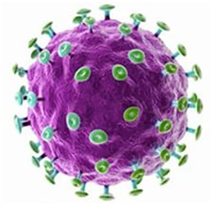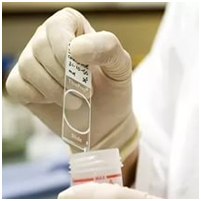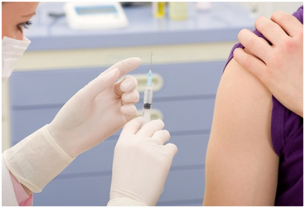
The human papillomavirus (HPV) infection is a major cause of morbidity and mortality worldwide. Today it is one of the most common viruses sexually transmitted. The risk of getting a virus is exposed to a significant portion of the population of different age groups.
Every tenth person on the planet is infected with this virus.
Some types of diseases associated with HPV affects women's reproductive function. There is a massive detection of new cases of cancer of the female reproductive system associated with human papillomavirus infection.
From history.
Lesions of the skin and mucous membranes known to mankind for over a Millennium. Called "genital warts", they were described by the doctors of Ancient Greece. The infection has gained prominence in the late twentieth century. The viral nature of warts was proven in the early twentieth century, about the sexual way of transmission was reported in 1954.
Frequency condylomatosis among the young and middle-age:
- 1981-1986 5.4 percent
- 1987-1999 gg - 19,1%
- now - up to 60%.
What is genital HPV infection?
HPV infection is a chronic viral disease transmitted from person to person through sexual contact.
The causative agent of the infection.
The causative agent-the human papillomavirus (HPV) is a common name for more than 80 types of viruses causing different diseases of the skin and mucous membranes of the body. Each HPV virus the group has its own serial number.

The human papilloma virus is detected:
- on the skin
- the mucous membranes of the oral cavity
- the mucous membranes of the conjunctiva
- the mucosa of the esophagus
- mucosa of the bronchi, larynx
- the rectal mucosa
- genital mucosa
The transmission of the virus.
Virus transmission occurs only from human to human. The main route of transmission - sexual.
Also possible:
- contact-household transmission of infection in the presence of microtrauma to the epithelium, the virus can enter the human body through scratches and abrasions, the virus from the infected person remains in the bath, the gym, the pool, on a towel, razor
- medical personnel can become infected by breathing dust during the removal of genital warts by laser, using infected surgical tools
- transmission from mother during pregnancy
Factors contributing to the emergence or recurrence of HPV:
- Hypothermia
- Hormonal disorders
- Medical procedures (abortion, the introduction of intrauterine devices)
- Pregnancy
Group HPV infections
- HPV does not cause cancer (warts on the skin)
- Low-risk HPV to develop cancer (different types of warts on the genitals)
- high-risk types (neoplastic diseases in women and men)
The prevalence of HPV-associated diseases in the world
- 21 000 Cancer of the vulva and vagina (women)
- 40 000 - Anal cancer (Among men)
- 60 000 - Anal cancer (Among women)
- 530 000 - cervical Cancer (Among women)
- 17 300 000 - Genital warts (men)
- 14 700 000 - Genital warts (females)
The incubation period of HPV infection can last from 2 months to 2-10 years, average 3 months.
For human papillomavirus infection is characterized by latent period.
Clinical picture.
The course of infection varied. It may spontaneously disappear, then again to progress.
Distinguish 3 forms of the disease:
- clinical - the presence of visible papillomas
- subclinical - no visible manifestations, asymptomatic, revealed only the additional examination (colposcopy or the study of cells)
- latent - is determined only by blood test
The main symptoms of human papillomavirus infection is the appearance:
- warts;
- warts - soft growths that are attached to the skin, thanks to the leg;
- genital warts - growths with a rough surface (mostly appear around the anus and the genitals).
These symptoms need to pay attention in the first place.
The consequences of infection with human papillomavirus:
- Cervical cancer is the second leading cause of death for women. Life expectancy of cases among women is reduced by an average of 26 years. It is proved that 70% of cervical cancer cases caused by HPV 16 and 18 types.
- Cervical cancer is a fully preventable disease if it's detected at an early stage of cancer or stage of precancer.
- Cancer of the vulva and vagina.
- Anal cancer. Every year there are nearly 100000 cases of this cancer.
- Cancer of the penis. Called in 35% of cases HPV 16 and 18, HPV 6 and 11-5% of cases.
- The anogenital warts. Are caused by HPV types 6 and 11. According to who, annually in the world recorded more than 30 million cases of venereal warts.
- For oropharyngeal cancer in young men.
How to determine the presence of virus in the body and its type?

In most cases the infection is asymptomatic, so the virus from the patient is usually detected only by using special analysis.
HPV diagnosis may include:
- clinical examination of the patient;
- examination of the cervix;
- Polymerase chain reaction (PCR) is an effective diagnostic method through which you can determine the type of virus;
- cytological examination under the microscope studied the character of cells (smear for Cytology from the uterine cervix);
- a blood test for detection of antibodies to HPV (such a method is used very rarely);
- the biopsy during the diagnostic procedure with "suspicious places" (such as warts or papillomas) take the bit of cloth. Granted, if there is a suspicion that the patient has cancer.
What is a PAP test?
This is a test, which can detect pre-cancerous or cancerous cells in the vagina and the cervix. From the surface of the cervix or channel with a special spatula smear is taken. Taken material is applied on the glass and sent to a laboratory where laboratory doctors carefully study the cellular structure. The test is named after the Greek scientist Georgios Papanicolaou.

When and to whom it is necessary to conduct a PAP test?
- You need to carry out PAP smear for every woman at least once a year since 18 years of age at first sex. In the absence of sexual contact, conduct the analysis, assume 1 every 3 years.
- Twice a year PAP smear is recommended when using hormonal contraception, and women suffering from genital herpes.
- The reason for more frequent smear tests is the frequent change of female sexual partners, overweight (obesity), infertility, the presence of genital warts genitals.
Prevention of human papillomavirus infection.
Considering the danger of the infection, the lack of efficiency of existing methods of treatment, it is imperative to prevention of this infectious disease.
Nonspecific prophylaxis:
- sex education for adolescents
- limiting the number of sexual partners
- condom use reduces transmission of HPV
- cervical screening, which is a regular survey of women with PAP test (cervical smear) for early detection and treatment of diseases
- quitting Smoking
Specific prevention:

Vaccination against the most dangerous (oncogenic) types of HPV for boys and girls aged 12-13 years before the onset of sexual activity and potential contact with HPV. After vaccination, formed a strong immunity.
Why it's necessary for the vaccine against human papillomavirus infection?
The human papilloma virus cause malignant transformation of cells, that is, is the cause of cancers, especially cervical cancer.
In recent years there is a rapid increase in the frequency of genital diseases in men, therefore, increasingly the question of the introduction of vaccination against HPV in both sexes.
At present, vaccination against HPV included in the vaccination calendar in 57 countries, six of them entered the vaccination of both sexes.
Vaccination efficiency reaches 98-100%, which has been proven in clinical studies.
The HPV vaccine is most effective before onset of sexual activity, but it is recommended that all women of young age.
The introduction of large scale vaccination will prevent up to 80-82% of all tumors in this group.
Prevention of human papillomavirus infection is one of the most important components of preventing cervical cancer in women and certain cancers in men.























